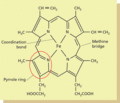
Figure 60.1
The haem molecule and its key structural features. The alternation of single and double bonds around the tetrapyrrole ring indicates the aromaticity o...

Figure 60.5
Typical subepidermal bulla in a bullous porphyria: (a) clinical appearance, and (b) histological appearance.

Figure 60.9
Porphyria cutanea tarda: erosions, blisters, pigmentary changes and scarring.

Figure 60.2
The pathway of haem biosynthesis showing the six key structural changes.
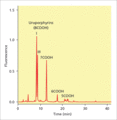
Figure 60.6
High‐performance liquid chromatography (HPLC) analysis: the more carboxylate groups it possesses, the faster a porphyrin molecule passes through the c...
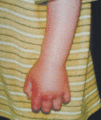
Figure 60.10
Oedema during an acute painful attack in a child with erythropoietic protoporphyria.

Figure 60.3
The pathway of haem biosynthesis showing the enzyme deficiency associated with each porphyria. Abbreviations of the disease names are defined in the t...
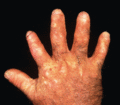
Figure 60.7
Congenital erythropoietic porphyria: scarring of skin with resorption of terminal phalanges. (Courtesy of Dr A. du Vivier, King's College Hospital, L...
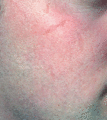
Figure 60.11
Typical scars on the cheeks in erythropoietic protoporphyria.

Figure 60.4
The pathogenesis of skin disease in porphyria.

Figure 60.8
Porphyria cutanea tarda is caused by production of an inhibitor of uroporphyrinogen decarboxylase (UROD) in the liver, in the presence of iron. (Adap...

Figure 60.12
Liver biopsy in protoporphyric liver disease showing nodules of cirrhosis and black staining by deposits of protoporphyrin.

